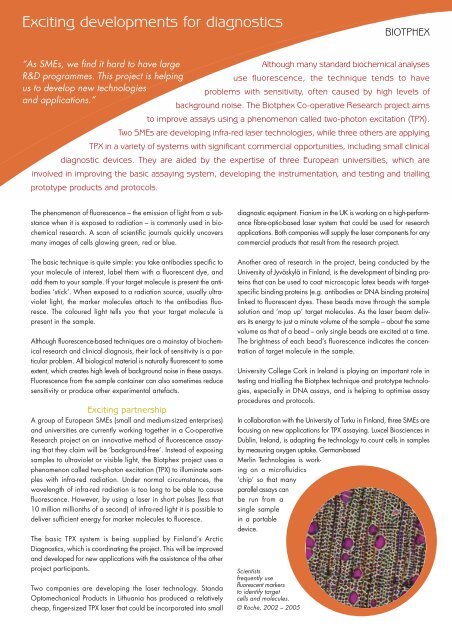Co-operative Research projects for SMEs - European Commission ...
Co-operative Research projects for SMEs - European Commission ...
Co-operative Research projects for SMEs - European Commission ...
You also want an ePaper? Increase the reach of your titles
YUMPU automatically turns print PDFs into web optimized ePapers that Google loves.
Exciting developments <strong>for</strong> diagnostics<br />
“As <strong>SMEs</strong>, we find it hard to have large<br />
Although many standard biochemical analyses<br />
R&D programmes. This project is helping<br />
use fluorescence, the technique tends to have<br />
us to develop new technologies<br />
problems with sensitivity, often caused by high levels of<br />
and applications.”<br />
background noise. The Biotphex <strong>Co</strong>-<strong>operative</strong> <strong>Research</strong> project aims<br />
to improve assays using a phenomenon called two-photon excitation (TPX).<br />
Two <strong>SMEs</strong> are developing infra-red laser technologies, while three others are applying<br />
TPX in a variety of systems with significant commercial opportunities, including small clinical<br />
diagnostic devices. They are aided by the expertise of three <strong>European</strong> universities, which are<br />
involved in improving the basic assaying system, developing the instrumentation, and testing and trialling<br />
prototype products and protocols.<br />
The phenomenon of fluorescence – the emission of light from a substance<br />
when it is exposed to radiation – is commonly used in biochemical<br />
research. A scan of scientific journals quickly uncovers<br />
many images of cells glowing green, red or blue.<br />
The basic technique is quite simple: you take antibodies specific to<br />
your molecule of interest, label them with a fluorescent dye, and<br />
add them to your sample. If your target molecule is present the antibodies<br />
‘stick’. When exposed to a radiation source, usually ultraviolet<br />
light, the marker molecules attach to the antibodies fluoresce.<br />
The coloured light tells you that your target molecule is<br />
present in the sample.<br />
Although fluorescence-based techniques are a mainstay of biochemical<br />
research and clinical diagnosis, their lack of sensitivity is a particular<br />
problem. All biological material is naturally fluorescent to some<br />
extent, which creates high levels of background noise in these assays.<br />
Fluorescence from the sample container can also sometimes reduce<br />
sensitivity or produce other experimental artefacts.<br />
Exciting partnership<br />
A group of <strong>European</strong> <strong>SMEs</strong> (small and medium-sized enterprises)<br />
and universities are currently working together in a <strong>Co</strong>-<strong>operative</strong><br />
<strong>Research</strong> project on an innovative method of fluorescence assaying<br />
that they claim will be ‘background-free’. Instead of exposing<br />
samples to ultraviolet or visible light, the Biotphex project uses a<br />
phenomenon called two-photon excitation (TPX) to illuminate samples<br />
with infra-red radiation. Under normal circumstances, the<br />
wavelength of infra-red radiation is too long to be able to cause<br />
fluorescence. However, by using a laser in short pulses (less that<br />
10 million millionths of a second) of infra-red light it is possible to<br />
deliver sufficient energy <strong>for</strong> marker molecules to fluoresce.<br />
The basic TPX system is being supplied by Finland’s Arctic<br />
Diagnostics, which is coordinating the project. This will be improved<br />
and developed <strong>for</strong> new applications with the assistance of the other<br />
project participants.<br />
Two companies are developing the laser technology. Standa<br />
Optomechanical Products in Lithuania has produced a relatively<br />
cheap, finger-sized TPX laser that could be incorporated into small<br />
diagnostic equipment. Fianium in the UK is working on a high-per<strong>for</strong>mance<br />
fibre-optic-based laser system that could be used <strong>for</strong> research<br />
applications. Both companies will supply the laser components <strong>for</strong> any<br />
commercial products that result from the research project.<br />
Another area of research in the project, being conducted by the<br />
University of Jyväskylä in Finland, is the development of binding proteins<br />
that can be used to coat microscopic latex beads with targetspecific<br />
binding proteins (e.g. antibodies or DNA binding proteins)<br />
linked to fluorescent dyes. These beads move through the sample<br />
solution and ‘mop up’ target molecules. As the laser beam delivers<br />
its energy to just a minute volume of the sample – about the same<br />
volume as that of a bead – only single beads are excited at a time.<br />
The brightness of each bead’s fluorescence indicates the concentration<br />
of target molecule in the sample.<br />
University <strong>Co</strong>llege <strong>Co</strong>rk in Ireland is playing an important role in<br />
testing and trialling the Biotphex technique and prototype technologies,<br />
especially in DNA assays, and is helping to optimise assay<br />
procedures and protocols.<br />
In collaboration with the University of Turku in Finland, three <strong>SMEs</strong> are<br />
focusing on new applications <strong>for</strong> TPX assaying. Luxcel Biosciences in<br />
Dublin, Ireland, is adapting the technology to count cells in samples<br />
by measuring oxygen uptake. German-based<br />
Merlin Technologies is working<br />
on a microfluidics<br />
‘chip’ so that many<br />
parallel assays can<br />
be run from a<br />
single sample<br />
in a portable<br />
device.<br />
Scientists<br />
frequently use<br />
fluorescent markers<br />
to identify target<br />
cells and molecules.<br />
© Roche, 2002 – 2005<br />
BIOTPHEX

















